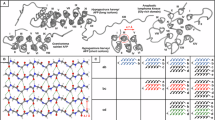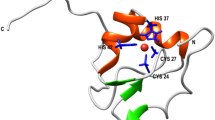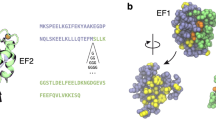Abstract
Comparison of the folding mechanisms of proteins with similar structures but very different sequences can provide fundamental insights into the determinants of protein folding mechanisms. Despite very little sequence similarity, the ∼60 residue IgG binding domains of protein G and protein L both consist of a single helix packed against a four-stranded sheet formed by two symmetrically disposed β-hairpins. We demonstrate that, as in the case of protein L, one of the two β-turns of protein G is formed and the other disrupted in the folding transition state. Unlike protein L, however, in protein G it is the second β-turn that is formed in the folding transition state ensemble. Substitution of an Asp residue by Ala in protein G that eliminates an i,i+2 side chain–main chain hydrogen bond in the second β-turn slows the folding rate ∼20-fold but has virtually no effect on the unfolding rate. Taken together with previous results, these findings suggest that the presence of an intact β-turn in the folding transition state is a consequence of the overall topology of protein L and protein G, but the particular hairpin that is formed is determined by the detailed interatomic interactions that determine the free energies of formation of the isolated β-hairpins.
This is a preview of subscription content, access via your institution
Access options
Subscribe to this journal
Receive 12 print issues and online access
$209.00 per year
only $17.42 per issue
Buy this article
- Purchase on SpringerLink
- Instant access to full article PDF
Prices may be subject to local taxes which are calculated during checkout




Similar content being viewed by others
References
Alm, E. & Baker, D. Curr. Opin. Struct. Biol. 9, 189–196 (1999).
Chiti, F. et al. Nature Struct. Biol. 6, 1005–1009 (1999).
Martinez, J.C. & Serrano, L. Nature Struct. Biol. 6, 1010–1016 (1999).
Riddle, D.S. et al. Nature Struct. Biol. 6, 1016–1024 (1999).
Ternstrom, T., Mayor, U., Akke, M. & Oliveberg, M. Proc. Natl Acad. Sci. USA 96, 14854–14859 (1999).
Plaxco, K.W., Simons, K.T. & Baker, D. J. Mol. Biol. 277, 985–994 (1998).
Alm, E. & Baker, D. Proc. Natl Acad. Sci. USA 96, 11305–11310 (1999).
Munoz, V. & Eaton, W.A. Proc. Natl Acad. Sci. USA 96, 11311–11316 (1999).
Galzitskaya, O.V. & Finkelstein, A.V. Proc. Natl Acad. Sci. USA 96, 11299–11304 (1999).
Gu, H., Kim, D. & Baker, D. J. Mol. Biol. 274, 588–596 (1997).
Kim, D.E., Fisher, C. & Baker, D. J. Mol. Biol. 298, 971–984 (2000).
Gronenborn, A.M. et al. Science 253, 657–661 (1991).
Gallagher, T., Alexander, P., Bryan, P. & Gilliland, G.L. Biochemistry 33, 4721–4729 (1994).
Alexander, P., Orban, J. & Bryan, P. Biochemistry 31, 7243–7248 (1992).
Alexander, P., Fahnestock, S., Lee, T., Orban, J. & Bryan, P. Biochemistry 31, 3597–3603 (1992).
Orban, J., Alexander, P., Bryan, P. & Khare, D. Biochemistry 34, 15291–15300 (1995).
Park, S.H., O'Neil, K.T. & Roder, H. Biochemistry 36, 14277–14283 (1997).
Blanco, F.J., Rivas, G. & Serrano, L. Nature Struct. Biol. 1, 584–590 (1994).
Kuszewski, J., Clore, G.M. & Gronenborn, A.M. Protein Sci. 3, 1945–1952 (1994).
Munoz, V., Thompson, P.A., Hofrichter, J. & Eaton, W.A. Nature 390, 196–199 (1997).
Kobayashi, N., Honda, S., Yoshii, H. & Munekata, E. Biochemistry 39, 6564–6571 (2000).
Park, S.H., Shastry, M.C. & Roder, H. Nature Struct. Biol. 6, 943–947 (1999).
Sheinerman, F.B. & Brooks, C.L. 3rd. Proteins 29, 193–202 (1997).
Sheinerman, F.B. & Brooks, C.L. 3rd. J. Mol. Biol. 278, 439–456 (1998).
Scalley, M.L., Nauli, S., Gladwin, S.T. & Baker, D. Biochemistry 38, 15927–15935 (1999).
Yi, Q., Michelle L. Scalley, Eric J. Alm & David Baker . J. Mol. Biol. in the press (2000).
Kortemme, T., Kelly, M.J., Kay, L.E., Forman-Kay, J. & Serrano, L. J. Mol. Biol. 297, 1217–1229 (2000).
Wikstrom, M., Drakenberg, T., Forsen, S., Sjobring, U. & Bjorck, L. Biochemistry 33, 14011–14017 (1994).
Gu, H. et al. Protein Sci. 4, 1108–1117 (1995).
Scalley, M.L. et al. Biochemistry 36, 3373–3382 (1997).
O'Neil, K.T., Hoess, R.H., Raleigh, D.P. & DeGrado, W.F. Proteins 21, 11–21 (1995).
Kraulis, P.J. J. Appl. Crystallogr. 24, 946–950 (1991).
Ferrin, T.E., Huang, C.C., Jarvis, L.E. & Langridge, R. J. Mol. Graph. 6, 13–27 (1988).
Huang, C.C., Pettersen, E.F., Klein, T.E., Ferrin, T.E. & Langridge, R J. Mol. Graph 9, 230–236, 242 (1991).
Merritt, E.A. & Murphy, M.E.P. Acta Crystallogr. D 50 869–873 (1994).
Bacon, D.J.A. & Anderson, W.F. Mol. Graph. 6, 219–220 (1988).
Acknowledgements
We thank K. O'Neil, L. Regan, and P. Alexander for providing constructs containing the protein G B1 domain. We also thank J. Tsai for Fig. 1b and members of the Baker lab for their helpful comments on the manuscript. This work was funded by a grant from the NIH.
Author information
Authors and Affiliations
Corresponding author
Rights and permissions
About this article
Cite this article
McCallister, E., Alm, E. & Baker, D. Critical role of β-hairpin formation in protein G folding. Nat Struct Mol Biol 7, 669–673 (2000). https://doi.org/10.1038/77971
Received:
Accepted:
Issue Date:
DOI: https://doi.org/10.1038/77971



